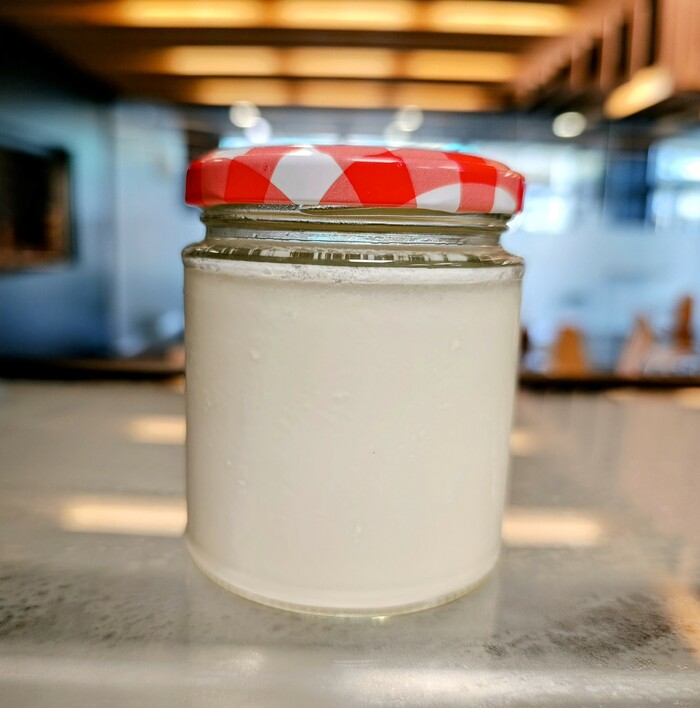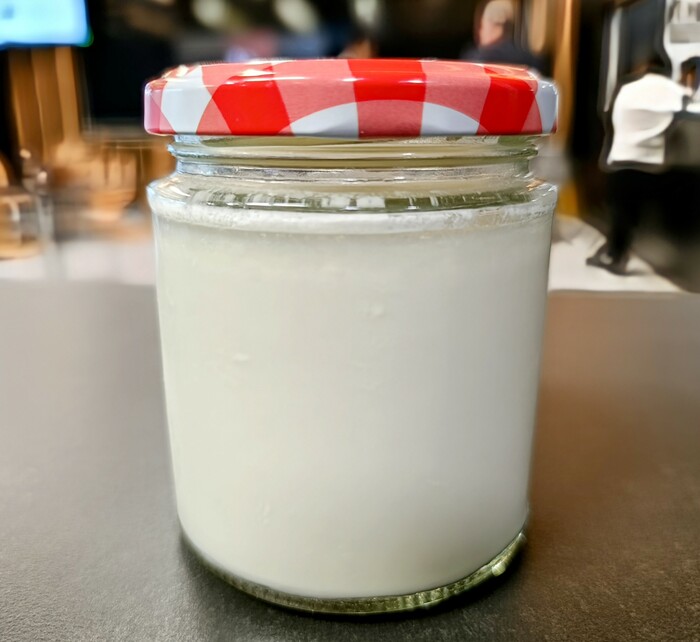Plain yogurt UHT
6 h
Seasonal period:
All year
Allergens:
Ingredients for 5 portions
Calculate portions
Sterilised milk
1.25 l
Fermento Mesófilo
0.15 g
Elaboration
- Throughout the processing process, attention must be paid to the hygiene of the manipulator, gloves are recommended and a mask must be used.
- Scrupulously hygienize all small materials and materials to be used in yogurt production to prevent contamination.
- The temperature of the space should be cool (not exceed, if possible, 20 ° C, if there is better ventilation).
- Choose the containers where the yogurt will be incubated.
- Heat UHT milk at 42ºC degrees.
- Add fermentable (it is important to know that if fermentation is 50 ° C it will NOT produce), dissolved in a little cold milk, moving for about 5 minutes to help dissolve in fermented milk.
- Gradually fill the selected vessels to avoid air bubbles and damage the texture.
- Once filled, cover the containers one by one with the lid.
- Put yogurt at temperatures up to 42 ° C for 6 hours.
- It's important to control the pH so it's about 6.5.
- We must land as soon as possible, and let him rest from one day to the next.
Keep it at 2 ° C for a maximum of 45 days, provided that all hygiene and health standards have been respected during the process.
Nutritional information (1 portion)
Energy
165.0
kcal
Carbohydrates
12.5
g
Proteins
8.25
g
Lipids
9.0
g
Sugars
12.5
g
Salt (Sodium)
250.0
mg
Folic acid
12.5
ug
Vitamin C
4.5
g
Vitamin A
87.5
ug
Zinc
0.75
mg
Iron
0.25
mg
Calcium
302.5
mg
Cholesterol
35.0
mg
Polyunsaturated fatty acids
0.23
g
Monounsaturated fatty acids
2.4
g
Saturates
4.88
g
Fiber
0.0
g
The data is merely a guide and should not be used for medical purposes. Those responsible for the web disclaims any responsibility.
-
Type of dish
- Beers
- Cocktails
- Breakfasts and brunch
- Burguers
- Juices, milkshakes and beverages
- Shellfish
- Bread and pastries
- Pizzas, patty
- Dessert
- Pasta
- Sándwich
- Pastries
- Finger foods
- Ice creams and sorbets
- Legumes
- Salads
- Eggs
- Patty
- liqueur
- Harvard plate
- Main course
- Meats
- Fish
- Birds
- Vegetables
- Soups and creams
- Rices
- Coffee, chocolate and infusion
- Cheeses
- Appetizers and canapes
- Temperature
- Cuisine type
- Additional culinary preparation
- Conservation technique
- Seasonal recipes
-
- Aromatic herbs
- Beverages
- Big game hunt
- Bread and pastries
- Canned goods and pickles
- Cereals
- Condiments, spices and additives
- Cooked, salted, preserved and cold meats
- Dried fruits and nuts
- Dry pulses
- Edible oils and vinegars
- Eggs and derivatives
- Feathered game hunt
- Fish cuts
- Fishes
- Insects
- Kitchen and bakery tecniques
- Kitchen and bakery utensils
- Meat cuts
- Meats
- Milk, cream and derivatives
- Mushrooms
- Offal
- Pasta, rice, flour and derivatives
- Poultry
- Seafood
- Service techniques
- Service utensils
- Vegetables cuts
- Vegetables, fruits, tubers and seaweed


